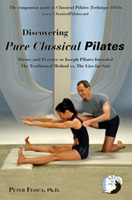Peter Fiasca's book, Discovering Pure Classical Pilates, exudes a wonderful reverence for the master, Joseph Pilates; and a contagious enthusiasm for the benefits of practicing Pilates in a purely classical way. It's a provocative book that draws a strong, clear line between what classical Pilates is, and isn't - which makes for very compelling reading. The lines around Pilates have gotten muddy. Having someone "lay down the law" is a wake up call, whether you agree with everything he says or not.
A Handbook of Classical Pilates :
Far from being another "how to do Pilates exercises" book, Discovering Pure Classical Pilates is a handbook for those looking for clear-cut direction about what what classical Pilates is, what it takes to become a classical instructor, and how to be a good classical Pilates instructor. As such, it is a must-read for classical Pilates instructors and those seeking to be one. But I would go further than that. I think this book is important reading for all of us who are seriously interested in Pilates.
Discovering Pure Classical Pilates takes a deep look at the roots of Pilates. As a community and industry, we need that. Not only is our history our foundation, but having a clear picture of the qualities of traditional Pilates gives us a kind of proving ground for our Pilates work. Fiasca seems to think that nothing but a classical approach can provide the full benefits of Pilates. That's not my view, but I do think it is critical that we question what we are doing and why. Fiasca's book is an excellent mirror for that kind of inquiry.
Defining Classical Pilates:
As part of defining classical Pilates, Fiasca goes through a wonderful compare and contrast of Pilates vs yoga, Pilates vs dance, Pilates vs physical therapy. Each part is detailed and insightful. Similarly, in an exploration of the body/mind/spirit integrative aspects of Pilates, Fiasca delves into the views of spirit in various religions and how those might relate, or not, to Joseph Pilates understanding of spirit. Whether you agree with all of Fiasca's conclusions or not, there is much to be learned by going on the journey with him.
Pilates and Psychology:
Fiasca, a Ph.D in Psychology, devotes a significant section of his book to a more personal instruction about how psychology and Pilates are related and different, and how psychological principles can inform Pilates instruction. This section is full of good tips for Pilates instructors, but also somewhat incongruous since Fiasca puts a lot of effort in the book into encouraging teachers to stay with just what Joseph Pilates taught, and dissuading people from adding their own spin to classical Pilates instruction.
Fiasca, Classical Pilates, and the Flat Back:
For many, one of the defining characteristics of classical Pilates has always been the instruction to do most exercises with a flat back. This is a sticky point for classical Pilates because science has proven that an absolutely straight spine is not the strongest or safest shape for the spine. Our 3 spinal curves are not aberrations. Addressing this, Fiasca says that a flat back and straight spine is not what Joseph Pilates meant -- that his meaning has been misunderstood.
Fiasca says Joseph Pilates meant that the back appears flat because the excessive curvatures are out of it. When I read what Joseph Pilates says in Return to Life Through Contrology, "The back would be flat if the spine were kept as straight as a plumb line, and its flexibility would be comparable to that of the finest watch." and in several exercise instructions, "the entire spine must rest on the mat." I'm still left with questions about Joseph Pilates intentions with regard to the flat back issue. He was not an imprecise guy.
Fiasca is resolving the flat back issue in a way that saves classical Pilates from an uncomfortable contradiction. However, with Fiasca's insistence that pure, classical Pilates must adhere to historical accuracy, I hope his interpretation of the flat back instruction is correct. Fiasca's credentials, including having studied extensively with Joseph Pilates protégé, Romana Kryzanowska, tip the scale in his favor.
Are You Part of "The Lies for Sale"?:
The subtitle of Discovering Pure Classical Pilates is: Theory and Practice as Joseph Pilates Intended The Traditional Method vs. The Lies for Sale. Yes, Fiasca packs a punch in this book. If you're not pure classical, you're not in. For the most part, according to Fiasca, contemporary Pilates, as many of us describe ourselves, is an inferior derivative.
If you are pure classical, you're going to feel good about yourself reading this book - and for some good reasons. If you're not purely classical, as I am not, you've got some choices to make about how to take it. I found it immensely valuable reading.
The Final Word:
Is Peter Fiasca the definitive spokesperson for classical Pilates? I leave that to the classical Pilates world to decide. He makes a point of excluding some folks who I know consider themselves truly classical, the U.S.P.A. for example, so I think there might be some interesting discussion around that.
For me, the bottom line on this book is that it is interesting and informative. It makes a strong stand for pure classical Pilates, and it is bound to be influential. Get it. Read it. Bring your thoughts about changing Pilates to the Pilates Forum.
Manufacturer's Site
